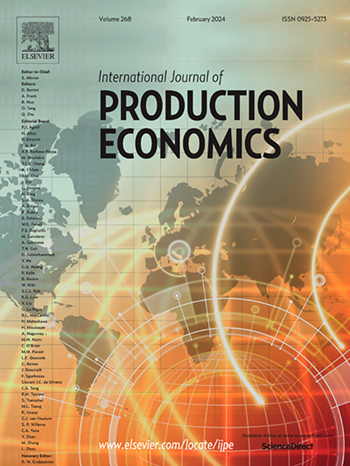The impact of big fund on the operational efficiency of semiconductor companies: Corporate social responsibility as a non-economic output
IF 9.8
1区 工程技术
Q1 ENGINEERING, INDUSTRIAL
引用次数: 0
Abstract
This study contributes to research on the total factor operational efficiency of the semiconductor company considering corporate social responsibility (CSR) by proposing a novel integer-valued nonparametric frontier method. This method adopts an endogenous directional distance function, which first selects the benchmark and then endogenously determines the directional vector. Avoiding the issue of non-integer slack adjustment increases the convenience of formulating incentive plans and calculating efficiency. We apply this method to the input–output data of 185 listed Chinese semiconductor companies from 2010 to 2022, considering integer-valued CSR as non-economic output. Global Malmquist productivity index analysis shows that the average total factor operational efficiency of companies that received investment from the National Integrated Circuit Industry Investment Fund (Big Fund) increased by 6.9%. Using the econometric technique, we verify that the total factor operational efficiency of semiconductor companies receiving Big Fund investment increased by 0.084 compared to those without Big Fund investment. Heterogeneity analysis showed that the effect of Big Fund was more significant in improving the total factor operational efficiency of state-owned, new, and non-integrated circuit semiconductor companies, implying the necessity of purposeful investment policies for the Big Fund.
大基金对半导体公司运营效率的影响:作为非经济产出的企业社会责任
本研究通过提出一种新颖的整数值非参数前沿方法,为考虑企业社会责任(CSR)的半导体公司全要素运营效率研究做出了贡献。该方法采用内生方向距离函数,首先选择基准,然后内生确定方向向量。避免了非整数松弛调整的问题,增加了制定激励计划和计算效率的便利性。我们将此方法应用于 185 家中国半导体上市公司 2010 年至 2022 年的投入产出数据,并将整数值的企业社会责任视为非经济产出。全球马尔奎斯特生产率指数分析表明,获得国家集成电路产业投资基金(大基金)投资的企业平均全要素运营效率提高了 6.9%。利用计量经济学技术,我们验证了获得大基金投资的半导体企业的全要素运营效率比没有获得大基金投资的企业提高了 0.084。异质性分析表明,大基金在提高国有、新型和非集成电路半导体企业全要素运营效率方面的效果更为显著,这意味着大基金有必要采取有目的的投资政策。
本文章由计算机程序翻译,如有差异,请以英文原文为准。
求助全文
约1分钟内获得全文
求助全文
来源期刊
CiteScore
21.40
自引率
7.50%
发文量
266
审稿时长
52 days
期刊介绍:
The International Journal of Production Economics focuses on the interface between engineering and management. It covers all aspects of manufacturing and process industries, as well as production in general. The journal is interdisciplinary, considering activities throughout the product life cycle and material flow cycle. It aims to disseminate knowledge for improving industrial practice and strengthening the theoretical base for decision making. The journal serves as a forum for exchanging ideas and presenting new developments in theory and application, combining academic standards with practical value for industrial applications.

 求助内容:
求助内容: 应助结果提醒方式:
应助结果提醒方式:


